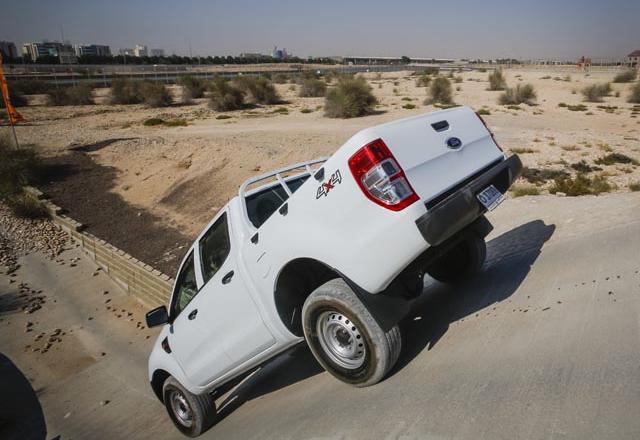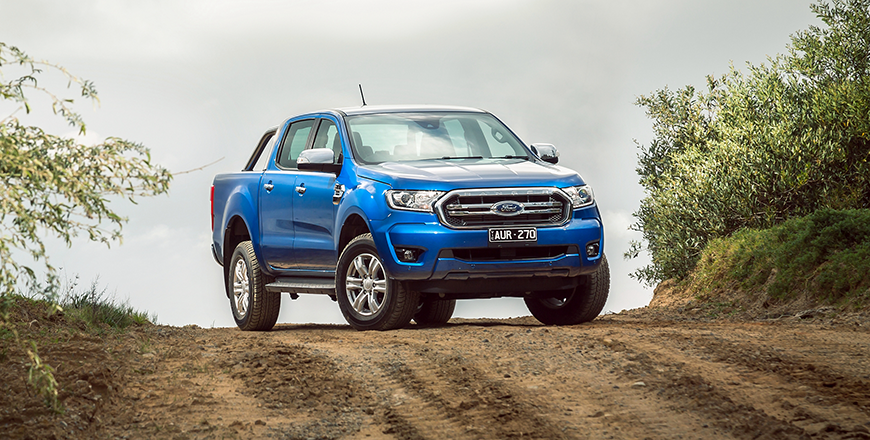You are here
Ford Ranger 3.2L: Confident, capable and charismatic
By Ghaith Madadha - Nov 29,2021 - Last updated at Nov 29,2021

Photo courtesy of Ford
Twice face-lifted since its introduction in 2011, the first generation Ford Ranger, built on the modern “T6” platform, remains as impressive as ever in its final year.
Even as a slightly larger, thoroughly updated and more technologically advanced second generation model nears production sometime towards the end of next year, the current Ranger remains one of the most capable, refined and viscerally appealing in its mid-size pick-up truck segment, and especially in 3.2-litre double cab dual personal and work use configuration.
Sculpted style
Updated in 2019 with improved tech, driver assistance and infotainment systems, and a subtle face-lift, the current Ranger gained a lightly more toned-down design than its immediate predecessor. With a clearly delineated horizontally-oriented front bumper design, the current Ranger has seemingly slimmer version of the aggressive prominently snouty hexagonal grille and scowling, heavily browed headlight aesthetic adopted in 2015. Little differentiated from side and front angles, the current Ranger retains the same upright stance, well-proportioned dimensions and ruggedly sculpted double cab body.
The most powerful Ranger bar the recently introduced high performance specialty Raptor variant available in limited markets, the Ranger 3.2L engine is offered regionally in three specification levels, including the outwardly more assertive, sportier and most highly equipped lifestyle-oriented Wildtrak version. Entry level XLT and mid-range LTD 3.2L Rangers are however little distinguishable in style and both feature chrome grille, rear bumper, accents and tubular cargo bed bar, rather than the Wildtrak’s black bumpers, accents, and sportier, more integrated rear bar.
Fluently muscular
Positioned longitudinally under a muscular clamshell bonnet, the region’s most powerful Ranger’s 3.2-litre common-rail turbo-diesel 5-cylinder engine — shared with the Mazda BT-50 — might be set for replacement by an advanced 3-litre V6 with the next generation Ranger, but remains most powerful and versatile among mid-size pick-up truck engines, as officially sold in Jordan. Developing 197BHP at 3000rpm and 347lb/ft torque throughout 1500-2750rpm, the Ranger 3.2L delivers brisk 10.6-second 0-100km/h acceleration, as combined with the 6-speed automatic gearbox option predominantly available in the region.
Responsive from idling engine speed with its quick spooling turbo and big displacement, the Ranger 3.2L’s intuitive automatic gearbox further helps with fluent delivery that avoids the low-end lag often associated with turbo-diesel engines. A muscular performer with deep, seemingly indefatigable mid-range pulling power, the Ranger 3.2L is characterised by its muscular on the move versatility That said, the Ranger 3.2L revs smoothly and consistently through to its low rev limit, and will confidently push through air resistance to a maximum 175km/h.
Generous abilities
Driving rear wheels for efficient regular road use, the Ranger’s four-wheel-drive can, however, be engaged at up to 120km/h, on-the-move, with which it effortlessly powers through most inclines and low traction conditions, including deep sand dunes. For even more demanding off-road conditions and towing, the Ranger features 2.48:1 low gear ratio reduction and locking rear differential. A capable off-roader, the Ranger meanwhile delivers generous high 230mm ground clearance, 800mm water wading capability, and 29° approach, 21° departure, 25° ramp and 35° tilt angles.
A capable off-roader, the Ranger’s rigid construction serves it well in terms of safety, off-road ability, durability and on-road handling ability and ride comfort. A composed and refined drive, despite its ruggedly utilitarian body-on-chassis construction and leaf sprung live axle rear suspension, the Ranger is settled at the rear, and is stable and reassuring at speed. Taking road imperfections in its stride, the Ranger is buttoned down over bumps and ruts, and delivers good in-class vertical control, and body lean control through corners.
Balanced workhorse
Agile and manoeuvrable for a truck, the Ranger 3.2L confidently hustles through switchbacks with its comparatively good steering feel, balanced weighting and double wishbone suspension. Tidy and responsive into corners, the Ranger powers out smoothly and with good grip. Easy to place through narrow paths and streets, the Ranger delivers good front visibility and a range of driver assistance systems depending on specification. However, XLT specification misses out on useful rear view camera and parking assistance features of LTD and Wildtrak versions.
Accessible and spacious for five, the Ranger’s cabin is ergonomic and user-friendly with pleasant design and good quality materials, including leather seats for the LTD model. Front seats meanwhile provide excellent comfort, supportive and adjustability. Well equipped with mod-cons and safety equipment, the Ranger 3.2L features either 4- or 8-inch infotainment screens. A capable workhorse, it accommodates a 1,180-litre cargo volume and 970kg payload in lightest 2,230kg XLT guise. XLT and LTD models, however, don’t receive the Wildtrak’s signature in-built lockable roll-top cargo bed cover.
TECHNICAL SPECIFICATIONS
Engine: 3.2-litre, common-rail turbo-diesel, in-line 5-cylinders
Bore x stroke: 89.9 x 100.8mm
Compression ratio: 15.7:1
Valve-train: 20-valve, DOHC
Gearbox: 6-speed automatic
Driveline: Four-wheel-drive, low gear transfer case, locking rear differential
Gear ratios: 1st 4.171:1; 2nd 2.342:1; 3rd 1.521:1; 4th 1.143:1; 5th 0.867:1; 6th 0.691:1
Reverse/final drive: 3.4:1/3.73:1
High/low range: 1:1/2.48:1
Power, BHP (PS) [kW]: 197 (200) [147] @3,000rpm
Specific power: 61.6BHP/litre
Torque, lb/ft (Nm): 347 (470) @1,750-2,500rpm
Specific torque: 147Nm/litre
0-100km/h: approximately 10.6-seconds
Top speed: 175km/h
Fuel consumption, urban/extra-urban/combined; 11.4-/7.4-/
8.9-litres/100km
CO2 emissions, combined: 234g/km
Fuel capacity: 80-litres
Wheelbase: 3,220mm
Track: 1,560mm
Ground clearance: 237mm
Water fording: 800mm
Approach angle: 29°
Break-over angle: 25°
Departure angle: 21°
Tilt angle: 35°
Wading depth: 800mm
Kerb weight: 2,230kg
Payload, Net: 970kg
Towing capacity, braked/un-braked: 3,500/750kg
Gross vehicle mass: 3,200kg
Gross train mass: 6,000kg
Suspension, F/R: Double wishbones, coilovers/leaf springs, live axle
Steering: Electric-assisted rack & pinion
Lock-to-lock: 3.5-turns
Turning circle: 12.7-metres
Brakes, F/R: Ventilated discs/drums
Tyres: 255/65R17
Related Articles
The range-topping version of Ford’s compact Ranger pick-up model line, the Wildtrak is a thoroughly capable hauler and off-roader with robus
Replacing both American and global market predecessors bearing the same badge, the new Ford Ranger light pick-up is a larger, more refined and more capable successor.
Launched last year globally and arriving in the Middle East for the 2020 model year, the latest face-lifted Ford Ranger incarnation includes



















